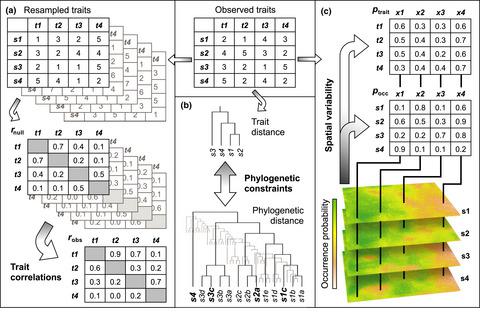当前位置:
X-MOL 学术
›
Glob. Change Biol.
›
论文详情
Our official English website, www.x-mol.net, welcomes your
feedback! (Note: you will need to create a separate account there.)
Trait-based ecology at large scales: Assessing functional trait correlations, phylogenetic constraints and spatial variability using open data.
Global Change Biology ( IF 10.8 ) Pub Date : 2020-09-08 , DOI: 10.1111/gcb.15344 Martin A Wilkes 1 , François Edwards 2 , J Iwan Jones 3 , John F Murphy 3 , Judy England 4 , Nikolai Friberg 5, 6 , Daniel Hering 7 , N LeRoy Poff 8 , Philippe Usseglio-Polatera 9 , Wilco C E P Verberk 10 , Jon Webb 11 , Lee E Brown 12
Global Change Biology ( IF 10.8 ) Pub Date : 2020-09-08 , DOI: 10.1111/gcb.15344 Martin A Wilkes 1 , François Edwards 2 , J Iwan Jones 3 , John F Murphy 3 , Judy England 4 , Nikolai Friberg 5, 6 , Daniel Hering 7 , N LeRoy Poff 8 , Philippe Usseglio-Polatera 9 , Wilco C E P Verberk 10 , Jon Webb 11 , Lee E Brown 12
Affiliation

|
The growing use of functional traits in ecological research has brought new insights into biodiversity responses to global environmental change. However, further progress depends on overcoming three major challenges involving (a) statistical correlations between traits, (b) phylogenetic constraints on the combination of traits possessed by any single species, and (c) spatial effects on trait structure and trait–environment relationships. Here, we introduce a new framework for quantifying trait correlations, phylogenetic constraints and spatial variability at large scales by combining openly available species’ trait, occurrence and phylogenetic data with gridded, high‐resolution environmental layers and computational modelling. Our approach is suitable for use among a wide range of taxonomic groups inhabiting terrestrial, marine and freshwater habitats. We demonstrate its application using freshwater macroinvertebrate data from 35 countries in Europe. We identified a subset of available macroinvertebrate traits, corresponding to a life‐history model with axes of resistance, resilience and resource use, as relatively unaffected by correlations and phylogenetic constraints. Trait structure responded more consistently to environmental variation than taxonomic structure, regardless of location. A re‐analysis of existing data on macroinvertebrate communities of European alpine streams supported this conclusion, and demonstrated that occurrence‐based functional diversity indices are highly sensitive to the traits included in their calculation. Overall, our findings suggest that the search for quantitative trait–environment relationships using single traits or simple combinations of multiple traits is unlikely to be productive. Instead, there is a need to embrace the value of conceptual frameworks linking community responses to environmental change via traits which correspond to the axes of life‐history models. Through a novel integration of tools and databases, our flexible framework can address this need.
中文翻译:

大规模基于特质的生态:使用开放数据评估功能性状相关性,系统发育限制和空间变异性。
功能性状在生态学研究中的使用日益广泛,为生物多样性对全球环境变化的反应带来了新的见解。但是,进一步的进展取决于克服三个主要挑战,这些挑战包括:(a)性状之间的统计相关性;(b)对任何单个物种拥有的性状组合的系统发育限制;(c)对性状结构和性状-环境关系的空间影响。在这里,我们引入了一个新的框架,通过将公开可用的物种的特征,发生和系统发育数据与网格化的高分辨率环境层和计算模型相结合,来大规模量化性状相关性,系统发育约束和空间变异性。我们的方法适用于居住在陆地,海洋和淡水栖息地。我们使用来自欧洲35个国家的淡水大型无脊椎动物数据证明了其应用。我们确定了一个可用的大型无脊椎动物性状的子集,该子集与具有抵抗力,适应力和资源使用轴的生命历史模型相对应,相对不受相关性和系统发育约束的影响。不论位置如何,特质结构对环境变化的反应都比分类结构更一致。对欧洲高山流域大型无脊椎动物群落的现有数据进行的重新分析支持了这一结论,并表明基于事件的功能多样性指数对其计算中包括的特征高度敏感。总体,我们的发现表明,使用单个性状或多个性状的简单组合来寻找数量性状与环境的关系不太可能产生成果。取而代之的是,需要接受概念框架的价值,该框架通过与生命历史模型的轴相对应的特征将社区对环境变化的反应联系起来。通过工具和数据库的新颖集成,我们灵活的框架可以满足这一需求。
更新日期:2020-09-08
中文翻译:

大规模基于特质的生态:使用开放数据评估功能性状相关性,系统发育限制和空间变异性。
功能性状在生态学研究中的使用日益广泛,为生物多样性对全球环境变化的反应带来了新的见解。但是,进一步的进展取决于克服三个主要挑战,这些挑战包括:(a)性状之间的统计相关性;(b)对任何单个物种拥有的性状组合的系统发育限制;(c)对性状结构和性状-环境关系的空间影响。在这里,我们引入了一个新的框架,通过将公开可用的物种的特征,发生和系统发育数据与网格化的高分辨率环境层和计算模型相结合,来大规模量化性状相关性,系统发育约束和空间变异性。我们的方法适用于居住在陆地,海洋和淡水栖息地。我们使用来自欧洲35个国家的淡水大型无脊椎动物数据证明了其应用。我们确定了一个可用的大型无脊椎动物性状的子集,该子集与具有抵抗力,适应力和资源使用轴的生命历史模型相对应,相对不受相关性和系统发育约束的影响。不论位置如何,特质结构对环境变化的反应都比分类结构更一致。对欧洲高山流域大型无脊椎动物群落的现有数据进行的重新分析支持了这一结论,并表明基于事件的功能多样性指数对其计算中包括的特征高度敏感。总体,我们的发现表明,使用单个性状或多个性状的简单组合来寻找数量性状与环境的关系不太可能产生成果。取而代之的是,需要接受概念框架的价值,该框架通过与生命历史模型的轴相对应的特征将社区对环境变化的反应联系起来。通过工具和数据库的新颖集成,我们灵活的框架可以满足这一需求。











































 京公网安备 11010802027423号
京公网安备 11010802027423号